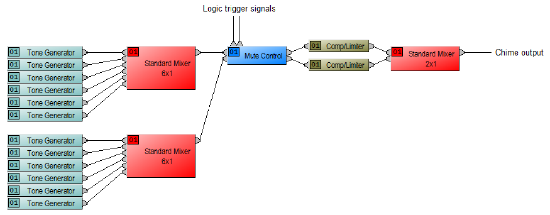Generating a chime tone in Audia/Nexia
Many applications, especially those that involve background music and paging, require a chime tone to be generated. There are plenty of options to build this in an Audia or Nexia file, depending on what type of chime is desired and how many notes are required. This article shows a sample using two notes but can be easily modified for three or more.
Building the chime generator
To build the chime generator, you'll need the following blocks:
- Two Tone Generator blocks
- A two-channel Mute block with control inputs enabled
- Two Compressor/limiters
- A 2x1 Standard Mixer
- Two NOT Gates
- A Flip Flop Gate
- A Logic Delay
Wire these blocks as shown below:
To trigger the chime, you'll need a momentary logic pulse as indicated above. This can be a logic signal coming from a logic box or other external controller.
Settings
Tone generators
- Ensure that the Tone Generators are unmuted.
- Set level to 0dBu.
- Set the desired frequencies. Here are some recommended values:
Tone Generator 1 frequency Tone generator 2 frequency 375 Hz 375 Hz 562.5 Hz 562.5 Hz 562.5 Hz 703.13 Hz 421.875 Hz 515.625 Hz 468.75 Hz 375 Hz
Compressors
- Set the attack time between 1500ms and 1800ms (this establishes the duration of the tone).
- Set release time to 50ms.
- Set compression ratio to 100:1.
- Set threshold to -60dBu.
Logic Delay
- Set the first Off Delay between 500ms and 1800ms. This determines the length of time before the second chime sounds.
- Set the second Off Delay time for the overall chime duration. As a rule of thumb, this time should be roughly the sum of both compressor attack times plus the first off delay time.
Harmonics
If the sound of pure tones is too boring, you can spice them up by adding harmonics. Almost all tonal or musical sounds are comprised of multiple tones instead of just a single tone at a single frequency. These additional tones can add depth and complexity to the sound, and make them more interesting and noticeable. Harmonics are also referred to as "overtones". Tones that have no harmonics or overtones are called "pure tones".
A chime tone will always have a fundamental frequency; the lowest frequency that is present in the sound. Harmonics are tones that are integer multiples of the fundamental frequency. For instance, if the fundamental frequency is 100 Hz, then its harmonics would be 200 Hz, 300 Hz, 400 Hz... If the fundamental frequency is 600 Hz, then the harmonics would be 1200 Hz, 1800 Hz, 2400 Hz... Harmonics are almost always lower in level than the fundamental frequency, and the lower harmonics are usually louder than the higher ones.
 In order to create a tone with harmonics, you'll need multiple tone generators that are getting mixed down to one signal. The frequency of the tone generators should all be integer multiples of the fundamental frequency (i.e. 2 times the fundamental frequency, 3 times the fundamental frequency, 4 times the fundamental frequency, etc.).
In order to create a tone with harmonics, you'll need multiple tone generators that are getting mixed down to one signal. The frequency of the tone generators should all be integer multiples of the fundamental frequency (i.e. 2 times the fundamental frequency, 3 times the fundamental frequency, 4 times the fundamental frequency, etc.).
Below are some examples of frequencies and levels that result in interesting tones. When replicating these tones, you don't necessarily need to use all six harmonics; in many cases, three harmonics are sufficient to get an interesting tone.
| Harmonic Number | Frequency | Level |
| 1 | 300 Hz | 0 dB |
| 2 | 600 Hz | -6 dB |
| 3 | 900 Hz | -9.5 dB |
| 4 | 1200 Hz | -12 dB |
| 5 | 1500 Hz | -14 dB |
| 6 | 1800 Hz | -15.5 dB |
| Harmonic Number | Frequency | Level |
| 1 | 250 Hz | 0 dB |
| 3 | 750 Hz | -9.5 dB |
| 5 | 1250 Hz | -14 dB |
| 7 | 1750 Hz | -16.9 dB |
| 9 | 2250 Hz | -19 dB |
| 11 | 2750 Hz | -20.8 dB |
| Harmonic Number | Frequency | Level |
| 1 | 220 Hz | 0 dB |
| 3 | 660 Hz | -19 dB |
| 5 | 1100 Hz | -28 dB |
| 7 | 1540 Hz | -33.8 dB |
| 9 | 1980 Hz | -38.2 dB |
| 11 | 2420 Hz | -41.7 dB |
| Harmonic Number | Frequency | Level |
| 1 | 400 Hz | 0 dB |
| 2 | 800 Hz | -12 dB |
| 4 | 1600 Hz | -18 dB |
| 6 | 2400 Hz | -21.6 dB |
| 8 | 3200 Hz | -24 dB |
| 10 | 4000 Hz | -26 dB |

